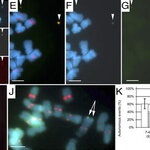Science category landing
Life Sciences

There are multiple reasons why the world is still plagued by diseases we cannot treat or vaccinate against and the overall complexity of the human immune system is one of them - in fact, say Danish researchers, each of our immune systems has a unique code-like mechanism that prevents it from being deceived.
They have developed a method to expose this crucial part of the immune system's defense mechanisms which could lead to entirely new vaccines and treatments.
The researchers from BioCentrum DTU and the Faculty of Health Sciences at the University of Copenhagen have created models of neural…

University of Utah biologists genetically manipulated nematode worms so the animals were attracted to worms of the same sex – part of a study that shows sexual orientation is wired in the creatures’ brains.
“They look like girls, but act and think like boys,” says Jamie White, a postdoctoral researcher and first author of the new study. “The [same-sex attraction] behavior is part of the nervous system.”
The study was published Thursday, Oct. 25 in Current Biology.
"The conclusion is that sexual attraction is wired into brain circuits common to both sexes of worms, and is not caused solely by…

Cilia, tail-like projections found on the surface of cells, are perhaps best known as molecular flippers that help cells move around. Recently, researchers have found that cilia are important for many other biological processes, including three of our five senses: vision, hearing, and smell (ciliopathies are often characterized by loss or deficiency in these senses). “That leaves two unexplored possibilities,” says Katsanis. “Taste and touch; we tried touch.”
Humans and genetically engineered mice lacking functional cilia respond more slowly to physical sensations such as exposure to hot…

With an eye on curing diabetes, scientists at Washington University School of Medicine in St. Louis have successfully transplanted embryonic pig pancreatic cells destined to produce insulin into diabetic macaque monkeys – all without the need for risky immune suppression drugs that prevent rejection.
The transplanted cells, known as primordia, are in the earliest stages of developing into pancreatic tissues. Within several weeks of the transplants, the cells became engrafted, or established, within the three rhesus macaque monkeys that received them. The cells also released pig insulin in…

Sifting through the massive backlog of microbial genome sequences from the public databases the US Department of Energy Joint Genome Institute identified genes that kill the bacteria employed in the sequencing process and throw a microbial wrench in the works. Their observations also offer a possible strategy for the discovery of new antibiotics.
Which goes to show; data that goes unnoticed, despite its widespread availability, can reveal extraordinary insights to the discerning eye.
In nature, promiscuous microbes share genetic information so readily that using genes to infer their species…

Ubiquitin is a small protein, which can be attached to other cellular proteins. A study headed by the Junior Group of Dr. Daniel Krappmann (GSF - National Research Center for Environment and Health, Institute of Toxicology) in collaboration with Dr. Jürgen Ruland (TU Munich) and Dr. Claus Scheidereit (Max-Delbrück-Center , Berlin) now reports a novel finding about ubiquitination as a key event for the activation of an immune response.
The acquired immune response is triggered after specific engagement of foreign peptides (antigens) by receptor molecules on white blood cell (lymphocytes).…

In animals with separate sexes, embryos commit to becoming male or female at an early stage. Often this key decision is made by sex determination genes on the sex chromosomes.
The genes involved in sexual development have changed remarkably little during evolution. In contrast, the sex determination genes and the sex chromosomes themselves are among the most rapidly changing features of the genome.
A research team formed by Sander van Doorn (Santa Fe Institute, USA) and Mark Kirkpatrick (University of Texas at Austin, USA) suggests an answer to the puzzle of why sex chromosomes evolve so…

Ancient, light-sensitive cryptochromes occur in corals, insects, fish and mammals - including humans - and are primitive light-sensing pigment mechanisms which predate the evolution of eyes.
New research regarding these genes by an international team of Australian and Israeli researchers has discovered what could be the aphrodisiac for the biggest moonlight sex event on Earth.
In a new paper published in Science today the team, headed by Dr Oren Levy of CoECRS and the University of Queensland, reports its discovery that the Cry2 gene, stimulated by the faint blue light of the full moon,…

A new clinical trial seeks to predict who is most likely to experience osteoarthritis, and to test whether an experimental treatment can prevent it altogether. Physicians are setting their sights on people who sustain a knee injury, seeking to understand why nearly half of them will later go on to develop osteoarthritis, a debilitating condition that causes pain and disability in more than 20 million Americans each year.
The work is funded by a special class of National Institutes of Health grants awarded to research programs that show promise of quickly translating basic science discoveries…

In the October 19, 2007, issue of PLoS-Genetics, a team of academic and commercial researchers (1) show that their "maize mini-chromosomes" (MMC) can introduce an entire "cassette" of novel genes into a plant in a way that is structurally stable and functional. Early results, the study authors say, "suggest that the MMC could be maintained indefinitely."
The production of transgenic plants, including maize, has historically relied on techniques that integrate DNA fragments into a host chromosome. This can disrupt important native genes or lead to limited or unregulated expression of the added…